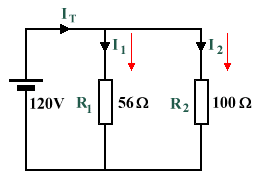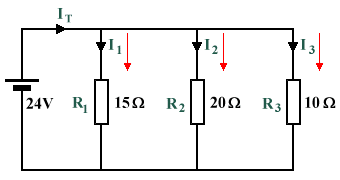Answers to Problems - The Current Divider
-
In the circuit illustrated below, two resistors are in parallel with a 120 V supply voltage. If the resistance values of R1 and R2 are 56 Ω and 100 Ω respectively, find the current flowing through each resistor (I1 and I2), the total current flowing through the circuit (IT), and the total circuit resistance (RT).

A current divider consisting of two resistors in parallel with a supply voltage
I1 = 120 V = 2.143 A (Ohm's law) 56 Ω
I2 = 120 V = 1.2 A (Ohm's law) 100 Ω
IT = 2.143 A + 1.2 A = 3.343 A (Kirchhoff's current law)
RT = 120 V = 35.896 Ω (Ohm's law) 3.343 A
-
In the circuit illustrated below, three resistors are in parallel with a 24 V supply voltage. If the resistance values of R1, R2 and R3 are 15 Ω, 20 Ω and 10 Ω respectively, find the current flowing through each resistor (I1, I2 and I3), the total current flowing through the circuit (IT), and the total circuit resistance (RT).

A current divider consisting of three resistors in parallel with a supply voltage
I1 = 24 V = 1.6 A (Ohm's law) 15 Ω
I2 = 24 V = 1.2 A (Ohm's law) 20 Ω
I3 = 24 V = 2.4 A (Ohm's law) 10 Ω
IT = 1.6 A + 1.2 A + 2.4 A = 5.2 A (Kirchhoff's current law)
RT = 24 V = 4.615 Ω (Ohm's law) 5.2 A